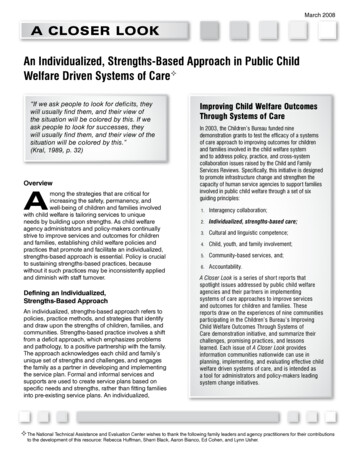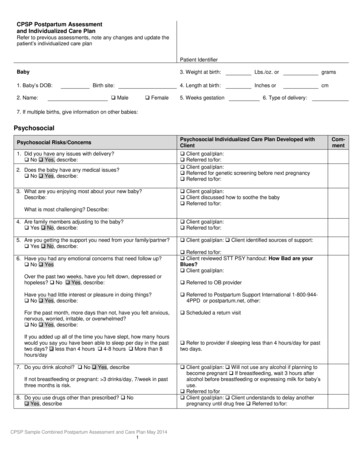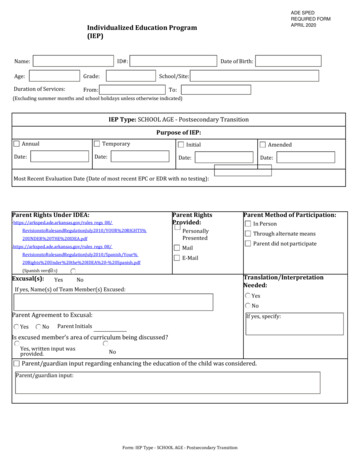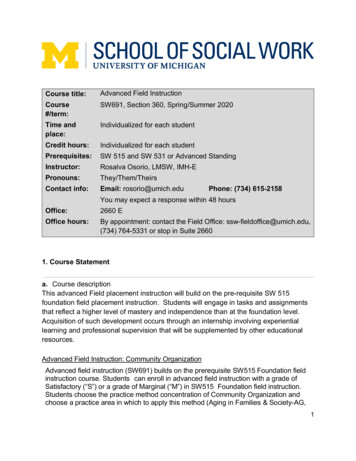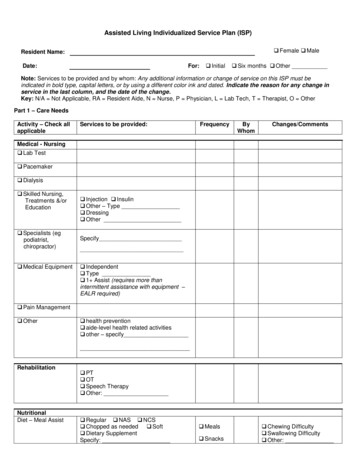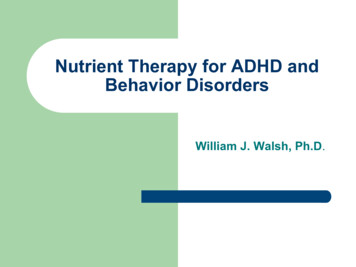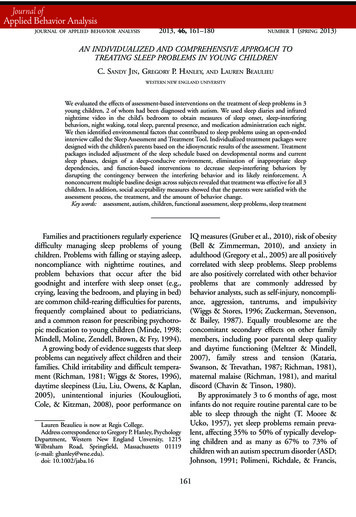
Transcription
JOURNAL OF APPLIED BEHAVIOR ANALYSIS2013, 46, 161–180NUMBER1 (SPRING 2013)AN INDIVIDUALIZED AND COMPREHENSIVE APPROACH TOTREATING SLEEP PROBLEMS IN YOUNG CHILDRENC. SANDY JIN, GREGORY P. HANLEY,ANDLAUREN BEAULIEUWESTERN NEW ENGLAND UNIVERSITYWe evaluated the effects of assessment-based interventions on the treatment of sleep problems in 3young children, 2 of whom had been diagnosed with autism. We used sleep diaries and infrarednighttime video in the child’s bedroom to obtain measures of sleep onset, sleep-interferingbehaviors, night waking, total sleep, parental presence, and medication administration each night.We then identified environmental factors that contributed to sleep problems using an open-endedinterview called the Sleep Assessment and Treatment Tool. Individualized treatment packages weredesigned with the children’s parents based on the idiosyncratic results of the assessment. Treatmentpackages included adjustment of the sleep schedule based on developmental norms and currentsleep phases, design of a sleep-conducive environment, elimination of inappropriate sleepdependencies, and function-based interventions to decrease sleep-interfering behaviors bydisrupting the contingency between the interfering behavior and its likely reinforcement. Anonconcurrent multiple baseline design across subjects revealed that treatment was effective for all 3children. In addition, social acceptability measures showed that the parents were satisfied with theassessment process, the treatment, and the amount of behavior change.Key words: assessment, autism, children, functional assessment, sleep problems, sleep treatmentFamilies and practitioners regularly experiencedifficulty managing sleep problems of youngchildren. Problems with falling or staying asleep,noncompliance with nighttime routines, andproblem behaviors that occur after the bidgoodnight and interfere with sleep onset (e.g.,crying, leaving the bedroom, and playing in bed)are common child-rearing difficulties for parents,frequently complained about to pediatricians,and a common reason for prescribing psychotropic medication to young children (Minde, 1998;Mindell, Moline, Zendell, Brown, & Fry, 1994).A growing body of evidence suggests that sleepproblems can negatively affect children and theirfamilies. Child irritability and difficult temperament (Richman, 1981; Wiggs & Stores, 1996),daytime sleepiness (Liu, Liu, Owens, & Kaplan,2005), unintentional injuries (Koulouglioti,Cole, & Kitzman, 2008), poor performance onLauren Beaulieu is now at Regis College.Address correspondence to Gregory P. Hanley, PsychologyDepartment, Western New England Unversity, 1215Wilbraham Road, Springfield, Massachusetts 01119(e-mail: ghanley@wne.edu).doi: 10.1002/jaba.16IQ measures (Gruber et al., 2010), risk of obesity(Bell & Zimmerman, 2010), and anxiety inadulthood (Gregory et al., 2005) are all positivelycorrelated with sleep problems. Sleep problemsare also positively correlated with other behaviorproblems that are commonly addressed bybehavior analysts, such as self-injury, noncompliance, aggression, tantrums, and impulsivity(Wiggs & Stores, 1996; Zuckerman, Stevenson,& Bailey, 1987). Equally troublesome are theconcomitant secondary effects on other familymembers, including poor parental sleep qualityand daytime functioning (Meltzer & Mindell,2007), family stress and tension (Kataria,Swanson, & Trevathan, 1987; Richman, 1981),maternal malaise (Richman, 1981), and maritaldiscord (Chavin & Tinson, 1980).By approximately 3 to 6 months of age, mostinfants do not require routine parental care to beable to sleep through the night (T. Moore &Ucko, 1957), yet sleep problems remain prevalent, affecting 35% to 50% of typically developing children and as many as 67% to 73% ofchildren with an autism spectrum disorder (ASD;Johnson, 1991; Polimeni, Richdale, & Francis,161
162C. SANDY JIN et al.2005; Souders et al., 2009). Although there is anotion that children eventually grow out of thedevelopmental phase characterized by sleepdisturbance, the persistence of these problemssuggests that they do not subside with age(Kataria et al., 1987; Zuckerman et al., 1987).Parents are likely to consult with pediatriciansfor assistance with sleep problems, but a nationalsurvey of pediatric residency programs found thatpediatricians receive only about 5 hr of trainingon addressing sleep problems. A significantnumber of pediatricians suggest to parents thatchildren will outgrow these problems (Mindellet al., 1994) and therefore do not prescribetreatment. When treatments are recommended,they are often pharmacological, and the prevalenceof pharmacological intervention is especially highfor children with disabilities who experience sleepproblems. Owens, Rosen, and Mindell (2003)surveyed a sample of 671 community-basedprimary care pediatricians and found that morethan 50% of them have prescribed medicationsand that more than 75% of them haverecommended nonprescription drugs for pediatric insomnia (insomnia refers to difficulties fallingor staying asleep). Stojanovski, Rasu, Balkrishnan, and Nahata (2007) reported that asmany as 81% of children’s visits to pediatricians,psychiatrists, and family physicians for sleepproblems result in medication prescriptions.These practices persist despite the lack of clearclinical guidelines for prescribing practices andlimited research on the long-term efficacy,tolerability, and social acceptability of pharmacological intervention (Rosen, Owens, Scher, &Glaze, 2002).The need for efficacious treatments to bothaddress and prevent sleep problems in youngchildren is obvious. Recent reviews of empiricallysupported treatments for pediatric sleep problemsencourage the application of strategies derivedfrom a behavior-analytic approach (Kuhn &Elliott, 2003; Mindell, 1999; Mindell, Kuhn,Lewin, Meltzer, & Sadeh, 2006). Although thebehavioral assessment and treatment literaturefocused on pediatric sleep problems is scarce incomparison to that available for other problembehavior (e.g., self-injury or classroom disruption; Kahng, Iwata, & Lewin, 2002), severalnotable studies have described effective intervention. For instance, France and Hudson (1990)demonstrated the success of a stimulus controlprocedure (e.g., routine bedtime stories prior toplacing the child in bed) and extinction (i.e., notattending to the child after the bid good nightunless absolutely necessary) for decreasing nightwaking and improving overall sleep quality inseven infants with sleep problems. Piazza andFisher (1991b) described an effective fadedbedtime with response cost procedure thatincreased the amount of appropriate sleep infour individuals with intellectual disabilities.Three children were being served in an inpatienthospital unit, and one child’s evaluation occurredwhile he was an outpatient. Treatment components involved (a) bidding the child goodnight30 min past the average sleep-onset time frombaseline and fading the bedtime earlier by 30 minon the next night if the child was able to fall asleepwithin 15 min of bedtime, (b) not allowing thechild to go to bed prior to the scheduled bedtimeor sleep past the scheduled wake time, and (c) aresponse cost procedure that involved keeping thechild awake and away from bed for 1 hr if sleeponset delay was more than 15 min. Ashbaughand Peck (1998) systematically replicated theseeffects in a home setting with a 2-year-oldtypically developing child. Considered together,Friman et al. (1999) and Freeman (2006)demonstrated the positive effects of extinctionand a bedtime pass on the sleep-interferingbehaviors (i.e., crying at night and leaving thebedroom) of six children of typical development.Using the pass resulted in a brief trip outside thebedroom and access to the parent’s attention. Insum, these studies demonstrate the efficacy ofbehavioral tactics for specific sleep problems.The behavioral literature is not without somelimitations. First, the extent to which caregiversare able to implement typical behavioral
SLEEP ASSESSMENTinterventions in home environments remainslargely unknown. More home-based studies, suchas that modeled in the single application byAshbaugh and Peck (1998), are needed withparents as the primary interventionists under theconditions in which children’s sleep problemstypically occur. Second, the majority of existingbehavioral studies rely exclusively on parentalreports of sleeping and waking (e.g., Ashbaugh &Peck; Freeman, 2006; Friman et al., 1999).Therefore, more behavioral interventions shouldbe evaluated with additional objective measurement systems in place. Third, most studies do notreport social validity measures or describeparental involvement in the development of theintervention; therefore, the social acceptability ofbehavioral interventions for sleep problemsshould be more routinely evaluated. Fourth,efficacious tactics such as faded bedtime withresponse cost (Ashbaugh & Peck; Piazza & Fisher,1991b), bedtime pass (Freeman, 2006; Frimanet al., 1999; B. A. Moore, Friman, Fruzzetti, &MacAleese, 2007), scheduled awakenings(Adams & Rickert, 1989; Johnson & Lerner,1985), positive routines (Adams & Rickert,1989; Christodulu & Durand, 2004; Milan,Mitchell, Berger, & Pierson, 1981), and variations of extinction (France & Blampied, 2005;France & Hudson, 1990; Lawton, France, &Blampied, 1991) are available; however, theprescription of these tactics is not necessarilyassessment based or predicated on idiosyncraticvariables that maintain sleep problems. Webelieve that effective and socially valid intervention is more likely when treatments are designedbased on an understanding of the individualfactors that influence the problem behavior, andtherefore should be individualized from assessment information.Behavioral, as opposed to pharmacological,treatment of pediatric sleep problems begins witha look at the target behavior through the lens of acontingency. We are interested in the behavior oflying quietly in bed and falling asleep. Procedurally, we focus on developing a period of163behavioral quietude (lying quietly in bed;Blampied & France, 1993) because it is ameasurable dimension that always precedes thetarget behavior of falling asleep. We begin withthe assumption that lying quietly and fallingasleep are operant behaviors maintained by thereinforcing event of sleep1 (Bootzin, 1977). Justas is the case for any other operant, stimuli in theenvironment acquire discriminative propertiesthat serve to signal the availability of thereinforcer, in this case, sleep. Discriminativestimuli that often occasion falling asleep includedimly lit rooms, cool temperatures, particularpillows, blankets, stuffed animals, rocking,patting, or the mere presence of a parent. Certainenvironmental operations may also establish thevalue of sleep as a reinforcer and evoke behaviorthat has historically resulted in that reinforcer,similar to the manner in which establishingoperations enter into contingencies that controlother important behavior (Michael, 1982).Deprivation of sleep, which may occur frominsufficient amounts of sleep, extended time sincelast sleep, or poor-quality sleep, establishes thevalue of sleep and momentarily increases theprobability of behavioral quietude. Certainsupplements or drugs like melatonin or clonidinealso can temporarily establish the value of sleep.The main point is that a coherent contingencyanalysis of sleep problems is possible whenbehavioral quietude and falling asleep are selectedas the target responses.Effective intervention is probably more likelywhen the controlling variables are also understoodfor operants that occur after a child is bid goodnight and that appear to interfere with behavioralquietude and thus preclude falling asleep.1It is important to note that a thorough account of sleepcannot be divorced from an understanding of the selectionhistory on a phylogenetic level (e.g., Heath, Kendler, Eaves,& Martin, 1990; M. Moore, Slane, Mindell, Burt, &Klump, 2011) and cultural level (e.g., cosleeping or sleepingalone; Jenni & O’Connor, 2005; Owens, 2004) in additionto that which is selected on an ontogenetic level (reinforcement history).
C. SANDY JIN et al.164Common interfering behaviors include calling outor leaving the bed, crying for parents to return tothe bedroom, eating, watching television, playingwith toys in bed, or talking to oneself in bed.Another assumption is that the reinforcers for theinterfering behavior may vary and may be eitherautomatic (i.e., they do not require mediation byanother person; e.g., reading books or repetitivelymanipulating toys or other objects) or sociallymediated, and may be either positive or negative.For example, crying out may be positivelyreinforced with a glass of milk or extended parentalpresence in the child’s bed. By contrast, crying outmay be negatively reinforced by a parent whoregularly removes the child from his or herbedroom when he or she cries. A thoroughgoingassessment of sleep problems would involve someattempt to identify the reinforcers for thesebehaviors as well as their associated establishingoperations and discriminative stimuli.The purpose of the present study was toaddress the aforementioned limitations of thebehavioral literature on pediatric sleep problems.We evaluated an assessment and treatment modelto be used by behavior analysts who work inhomes with parents in an attempt to resolve oneor more of their child’s sleep problems. The goalof this model was to develop individualized,comprehensive, and socially acceptable interventions to address sleep problems based on theidiosyncratic results of assessment. Data on theefficacy and acceptability of the model arepresented for three families.METHODParticipants and SettingsThree children, 7 to 9 years old, and theirparents participated in our evaluation. They wererecruited via flyers posted at local child-care centersand pediatricians’ offices. They were the second,third, and fourth children to participate in theWestern New England University’s sleep program(the first participant’s sleep data were used to refineour measurement systems). The parents of all threechildren indicated that the sleep problems hadpersisted for many years and were highly stressfuland disruptive to their family life.Walter was a 7-year-old typically developingboy who reportedly experienced delayed sleeponset. Walter’s parents often discovered that hewas still awake 1 or more hours after bidding himgoodnight. Parents said that he took items such astoys, stuffed animals, or books to his bed when itwas time for sleep. They also reported that hetalked to himself or got out of bed to askquestions or communicate his inability to fallasleep. Walter had been taken to an outpatientclinic for evaluation of obsessive and compulsivebehavior, but neither assessment nor treatmentaffected his sleep patterns. Although he wasreported to usually sleep through the night, hisparents found him to appear tired when he wokeup in the morning. Parents had attempted toremove books and toys from the bedroom,instructed Walter to count sheep, talked to himabout the questions he asked, or instructed himto think about events that occurred during theday to help him fall asleep. Parental goals forWalter’s sleep included reduction of sleep-onsetdelay to 30 min or less, elimination of sleepinterfering behavior, and achievement of an ageappropriate amount of sleep (about 10.5 hr).Andy was a 9-year-old boy who had beendiagnosed with an ASD and who reportedlyexperienced delayed sleep onset and nightawakenings of extended duration. Parents reported that they had a difficult time settling himto bed because he engaged in stereotypy in theform of body rocking, head shaking, andrepetitive manipulation of items such as papers,socks, clothes, or pillowcases during bedtime. Healso screamed and threw tantrums on someoccasions. Parents often found Andy awake whenthey checked on him in the middle of the night orearly in the morning with socks or other clothingitems out of the drawers. They had previouslyattempted to put Andy in a tight wrap prior tobedtime, to hide in the bedroom and instruct himto go to bed, to hold him in bed when he did not
SLEEP ASSESSMENTstay in bed, and to give him cold baths as part ofthe bedtime routine to help settle him to sleep.Clonidine had also been prescribed for his sleepproblems and had been administered for about12 months prior to our study. His parentsexpressed concern about potential side effectsassociated with its prolonged use. Parental goalsfor Andy’s sleep were to reduce sleep-onset delayto 15 min or less, to eliminate sleep-interferingbehaviors, to reduce night wakings, and toeliminate medication.Lou was also a 9-year-old boy with an ASDwho reportedly experienced difficulty fallingasleep and frequently woke up in the middle ofthe night or early in the morning. His parentsreported that he frequently got out of bed torequest that a parent sleep with him. If a parentdid not lie down with Lou, he was reported tosing songs, walk around the house to turn on allthe lights, or try to sleep in the parents’ bedroom.Lou’s father had been staying or sleeping on thefloor in Lou’s bedroom almost every night untilLou fell asleep to prevent him from leaving thebedroom. Lou’s mother had also tried to lie withhim in bed until he fell asleep or when he woke upin the middle of the night. Both parents reportedpoor sleep quality of their own due to constantnighttime interactions with Lou. Melatonin andBenadryl had also been used to address the sleepproblems in the past but with reported limitedsuccess. Parental sleep goals for Lou werereduction of sleep-onset delay to 15 min orless, elimination of interfering behaviors, reduction of night and early wakings, achievement ofan age-appropriate amount of sleep (about 10.25hr), and elimination of parental presence at night,medication, and supplements.The study took place in the children’s homes,and their parents implemented all treatmentcomponents. All three children slept in their ownbedrooms (i.e., without siblings). Walter slept ina regular bed without rails, Andy slept on abottom bunk bed, and Lou slept in a bed withrails. All three children went to bed in dark ordimly lit bedrooms (with night-lights).165Measurement SystemsSleep diaries. We asked the parents to observeand record information each day about theirchild’s sleep. Parents documented the time (a)they bid the child goodnight, (b) when the childfell asleep, (c) of night awakenings and resumption of sleep (if any), (d) of morning awakening,and (e) of any naps during each 24-hr cycle. Thesleep diary also included open-ended questionsregarding bedtime routine noncompliance, sleepinterfering behaviors, and parental presence orcosleeping (if any).Infrared nighttime video. A Sony high-definition camcorder with infrared illumination wasplaced in an inconspicuous location in each child’sbedroom. The camcorder continuously recordedthe child’s nighttime behavior. Parents wereinstructed to turn on the camcorder and itsnight-shot mode before bidding the child goodnight and to turn off the camcorder in themorning shortly after beginning the morningroutine. Video recordings served to complementthe information obtained from the sleep diary andallowed us to more precisely measure the child’ssleep-interfering behaviors during the settlingperiod. Observation, however, was limited tobehavior that occurred in and around each child’sbed. Video data were collected on a minimum of30% of the nights with each family, but weobtained as much video data as possible. Theamount of obtained video data depended on theavailability of the camcorder and the number oferrors in setting up the equipment (e.g., nightshot mode not turned on or the camcorder notplugged in at night).Dependent VariablesSleep-onset delay was defined as the amount oftime (in minutes) elapsed from when the parentsbid the child goodnight to when the child fellasleep. We observed the child from biddinggoodnight to falling asleep continuously via videoto record the duration of sleep-onset delay usingdata-collection software. Data collectors turnedon an assigned key when bidding goodnight to
166C. SANDY JIN et al.the child and turned it off when 10 min hadelapsed without any signs of being awake (seeawake definition below).Sleep-interfering behaviors were characterizedas any behavior that occurred after biddinggoodnight that may interfere with behavioralquietude and falling asleep. We defined interferingbehavior as time (in minutes) spent (a) vocalizing(any audible vocalization coming from the childsuch as singing, humming, giggling, crying, callingout, making requests, talking, or screaming withthe exclusion of sneezing, coughing, or yawning),(b) getting out and staying out of bed (child left thethe bed or was not in bed), (c) sitting up (no contactbetween back and head to any part of the bed) orstanding in bed, and (d) engaging in stereotypy(head shaking, body rocking, or the child’s handsactively manipulating or repeatedly flapping anyitems such as books, video games, toys, papers,socks, clothing pieces, pillowcases, and curtains).Sleep-interfering behavior was recorded from thevideo, and real-time data were collected using thesame computer data-collection program.We used paper and pencil to record entire sleepduration using a time-sampling procedure with30-min intervals. The observation period duringeach sampling interval was 1 min to allowsufficient time to examine whether the childwas asleep or awake (i.e., we observed for 1 minevery 30 min to detect whether the child wasawake or asleep in bed). Asleep was defined as thechild in bed lying on his back, stomach, or sidewithout any signs of being awake, or coverscovered his entire body with minimal physicalmovement. Awake was defined as any occurrenceof sleep-interfering behavior (see definitionabove) with the addition of eyes open (if eyeswere visible), whispering, looking up with headleaving pillow, quiet babbling, quiet humming,or excessive physical movement in bed or underthe blanket. After we scored the entire night ofvideo using the time-sampling procedure, wecalculated total sleep by summing the number ofasleep intervals and multiplying it by 30 min. Wethen calculated percentage of sleep during goalhours by dividing the amount of sleep within theideal sleep zone by the goal amount of sleep andconverting the result to a percentage. Ideal sleepzone was determined with sensitivity to theparents’ goal and the developmentally appropriate amount of sleep (Ferber, 2006; Weissbluthet al., 1981). We calculated duration of nightwaking by summing the number of awakeintervals from when the child fell asleep to 1 hrprior to the child’s appropriate wake time(determined from each child’s developmentalnorms) and multiplying the sum by 30 min.In sum, direct measures from the video wereavailable for sleep-onset delay, individual topographies of sleep-interfering behavior, nightwaking, and amount of sleep. The same measures(with the exception of interfering behavior) werealso available from the diaries. Calculation for alldiary-based measures followed the same criteria asthe video-based measures. Finally, we recordedother events, such as bedtime music, parentalpresence, and the use of clonidine, melatonin, orBenadryl from the sleep diaries.Interobserver AgreementInterobserver agreement was assessed byhaving a second observer independently scoreat least 20% of baseline and treatment videosessions for all three children. Agreement data forsleep-onset delay, overall sleep-interfering behavior, and specific sleep-interfering behaviors(vocalizations, out of bed, sitting up or standing,and stereotypy) were collected for 43%, 36%,and 25% of baseline sessions and 24%, 28%, and22% of treatment sessions for Walter, Andy, andLou, respectively, and 20% of follow-up sessionsfor Walter. Agreement was calculated by partitioning the observation duration (i.e., frombidding goodnight until the child fell asleep)into 10-s intervals and dividing the smallerduration of scored responses by the largerduration within each interval; results were thenconverted to a percentage and averaged across allintervals. For all three children, mean agreementwas 95% for sleep-onset delay (range, 81% to
SLEEP ASSESSMENT100%), 97% for vocalizations (range, 86%to 100%), 99% for out of bed (range, 93% to100%), 97% for sitting up and standing (range,85% to 100%), and 99% for stereotypy (range,90% to 100%).Agreement data for asleep and awake werecollected for 29%, 21%, and 25% of baselinesessions and 24%, 20%, and 22% of treatmentsessions for Walter, Andy, and Lou, respectively,and 20% of follow-up sessions for Walter.Observers’ data were compared on an intervalby-interval basis. An agreement was scored in anyinterval in which both observers scored eitherawake or asleep, and a disagreement was scored inany interval in which one observer scored awakeand the other scored asleep. Agreement statisticswere calculated by dividing the number ofagreement intervals by the number of agreementplus disagreement intervals and converting theresult to a percentage. For all three children, meanagreement was 100%.ProcedureBaseline. Prior to baseline, we obtained basicinformation on each child’s sleep problems andensured that there were no severe medical orhealth-related concerns (all children had beenevaluated by their physicians to rule out insomniasecondary to a medical condition). We informedthe parents about the study’s purpose, procedures, and measurement commitments (i.e.,diary and in-home video recordings) andobtained consent for participation. At thebeginning of baseline, we instructed the parentsnot to change anything they had been doing topromote good sleep. Parents worked with theirpediatricians to alter and ultimately eliminatemedications for sleep during baseline.Assessment. After collecting an amount ofbaseline data that was sufficient to detecttreatment effects, we arranged an open-endedinterview with each family, which was guided bythe Sleep Assessment and Treatment Tool (SATT;see Supporting Information for relevant sectionsof the SATT). The SATT is an open-ended167functional assessment interview designed toidentify specific sleep problems and the idiosyncratic environmental variables that contribute toeach child’s sleep problems in order to inform anindividualized intervention that each family findsacceptable. Specific features of the interviewinclude (a) history of the child’s sleep problems;(b) a joint determination of sleep goals; (c)identification of specific sleep problems (e.g.,bedtime routine noncompliance, delayed sleeponset, night awakenings, early awakenings), adescription of the antecedent conditions underwhich the specific sleep problems occurred, andthe types of interactions (if any) that occurfollowing the specific sleep problems; (d)identification of the child’s current sleep scheduleand likely sleep dependencies (those items,events, or interactions that appeared to occasionsleep), (e) identification of the topographies ofpossible interfering behaviors and their likelyreinforcers, and (f ) descriptions of treatmentoptions from which parents can choose. Theresults obtained from the interview (and observations from the video) informed the design ofindividualized and comprehensive treatments.Treatments. Comprehensive treatments foreach child included procedures to enhance theestablishing operations and discriminative stimulifor behavioral quietude and to weaken thecontingencies for sleep-interfering behaviors. Toreduce sleep-onset delay, we attempted toestablish the value of sleep by adjusting thechild’s sleep schedule based on developmentalnorms and their current sleep phases (Piazza &Fisher, 1991b). To reduce sleep-interferingbehavior, we disrupted the contingency betweenthe interfering behavior and its putative reinforcement and provided access to the putativereinforcer only before bedtime or independent ofthe interfering behavior. Night waking wasindirectly addressed with treatments for interfering behavior, but we also attempted to eliminateinappropriate sleep dependencies (e.g., eventsthat were present only during the settling period,e.g., music) and to establish gradually new sleep
168C. SANDY JIN et al.dependencies on salient events that were availableat bedtime and throughout the night. Total sleepwas indirectly addressed by these components.Walter. Assessment results indicated that Walter had delayed sleep onset and was usually bidgoodnight at least 1 hr before he fell asleep. Wefirst established the value of sleep by biddingWalter goodnight closer to his natural sleep phase(when he typically fell asleep). We did this bypushing Walter’s bedtime forward by 1 hr andgradually moving it back by 30 min if he fellasleep within 30 min (his goal range of sleeponset delay had been determined jointly with hisparents) until a desirable bedtime was reached. Wealso asked the parents to keep his sleep scheduleconsistent so that the amount of sleep he receivedeach night was developmentally appropriate.Walter also engaged in sleep-interfering behavior in the forms of (a) manipulating items such asbooks, magazines, or paper that were in his bed atbedtime; (b) periodically interacting with siblings;and (c) getting out of bed to ask “big questions”pertaining to mathematics or religion or tocommunicate his inability to fall asleep. Basedon assessment results, the putative reinforcers forWalter’s sleep-interfering behavior were access tobooks, magazines, papers, and parental or siblingattention. For treatment, we instructed parents toprovide access to these putative reinforcers beforebedtime by allowing access to books, magazines,and paper for at least 20 min before getting readyfor bed, and by arranging a period of qualitativelyrich social interaction and a period of questionasking and answering with the parents. Access tothese same putative reinforcers was then restrictedafter bedtime by making items such as books andma
nighttime video in the child's bedroom to obtain measures of sleep onset, sleep-interfering behaviors, night waking, total sleep, parental presence, and medication administration each night. We then identified environmental factors that contributed to sleep problems using an open-ended interview called the Sleep Assessment and Treatment Tool.

